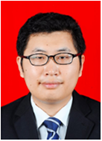Group > Faculty > Dexiang Wang

Name:Wang Dexiang
Gender:Male
Academic degree:Doctor of Engineering
Title:Assistant professor
Master's degree instructor, high-level outstanding talents in Qingdao University of Technology, mainly engaged in the research work of abrasive grain processing theory and application technology. I presided over 6 national, provincial and ministerial-level scientific research projects, participated in 6 national, provincial and ministerial scientific research projects, and published more than 20 papers. Among them, the first author published 11 SCI/EI papers.
Field of research
1. Abrasive grain processing theory and application
2. Controlled manufacture of rolling bearing raceway
3. Micro-grinding mechanism and application
Research subject
[1] The Heat Transfer and Tribological Mechanism on Grinding Interface under Cryogenic Minimum Quantity Lubrication with Graphene/Ionic Liquid Nanofluid, 2018/01~2020/12.
[2] The tribological behavior of nanoparticles on grinding interface under minimum quantity lubrication, 2018/11~2020/11.
[3] The tribological mechanism of friction-reducing and anti-wear of spherical nanoparticles on grinding interface under nanofluid minimum quantity lubricationt, 2018/11~2020/11.
[4] The tribological mechanism of nanofluids to improve the characteristics of lubrication film on grinding interface under minimum quantity lubrication, 2019/08~2021/08.
[5] Surface integrity controlled grinding of bearing raceway based on cryogenic nanofluid minimum quantity lubrication, 2022/06~2025/05.
Research findings
[1] Wang D, Zhang Y, Zhao Q, et al. Tribological mechanism of carbon group nanofluids on grinding interface under minimum quantity lubrication based on molecular dynamics simulation[J]. Frontiers of mechanical engineering, 2023, 18(1): 17.
[2] Wang D, Zhao Q, Zhang Y, et al. Investigation on Tribological Mechanism of Ionic Liquid on Grinding Interfaces under MQL [J]. China Mechanical Engineering, 2022, 33(05): 560-568. (In Chinese)
[3] Wang D, Sun S, Tang Y, et al. Molecular dynamics simulation for grinding interface under minimum quantity lubrication [J]. Journal of Xi'an Jiaotong University, 2020, 54: 168-175. (In Chinese)
[4] Wang D, Sun S, Jiang J, et al. From the grain/workpiece interaction to the coupled thermal-mechanical residual stresses: an integrated modeling for controlled stress grinding of bearing ring raceway[J]. The International Journal of Advanced Manufacturing Technology, 2019, 101(1-4): 475-499.
[5] Wang D, Sun S, Yan B, et al. Modeling of heat source on machined surface and numerical simulation for grinding temperature field[J]. Journal of Xi'an Jiaotong University, 2018, 52(4): 84-89. (In Chinese)
[6] Wang D, Sun S, Jiang J, et al. The profile analysis and selection guide for the heat source on the finished surface in grinding[J]. Journal of Manufacturing Processes, 2017, 30:178-186.
[7] Wang D, Ge P, Sun S, et al. Investigation on the heat source profile on the finished surface in grinding based on the inverse heat transfer analysis[J]. International Journal of Advanced Manufacturing Technology, 2017, 92(2):1-16.
[8] Wang D, Ge P, Bi W, et al. Heat source profile in grinding zone[J]. Journal of Xi'an Jiaotong University, 2015, 49(8):116-121. (In Chinese)
[9] Wang D, Ge P, Bi W, et al. Experimental study on residual stress distribution in surface layer of rolling bearing inner ring raceway[J]. Journal of Huazhong University of Science and Technology (Natural Science Edition), 2015(3):12-16. (In Chinese)
[10] Wang D, Ge P, Bi W, et al. Grain trajectory and grain workpiece contact analyses for modeling of grinding force and energy partition[J]. International Journal of Advanced Manufacturing Technology, 2014, 70(9-12):2111-2123.
[11] Wang D, Ge P, Zhang L, et al. Statistical Calculations of Grinding Abrasive Number Based on Normal Distribution[C]. Applied Mechanics & Materials, 2012, 229-231:474-477.